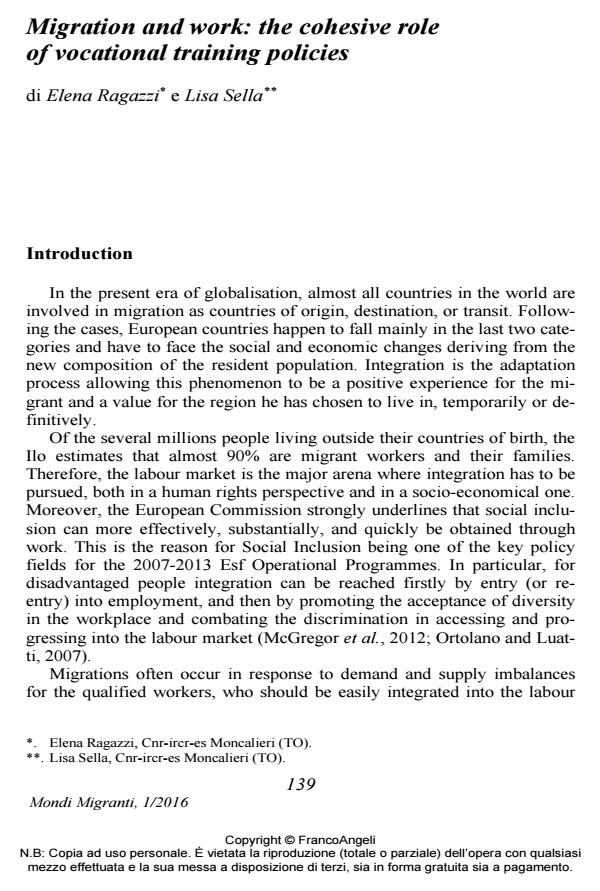Migration and work: the cohesive role of vocational training policies
Journal title MONDI MIGRANTI
Author/s Lisa Sella, Elena Ragazzi
Publishing Year 2016 Issue 2016/1
Language English Pages 22 P. 139-160 File size 104 KB
DOI 10.3280/MM2016-001008
DOI is like a bar code for intellectual property: to have more infomation
click here
Below, you can see the article first page
If you want to buy this article in PDF format, you can do it, following the instructions to buy download credits

FrancoAngeli is member of Publishers International Linking Association, Inc (PILA), a not-for-profit association which run the CrossRef service enabling links to and from online scholarly content.
Migration and work are truly connected notions in the European social model. Work is a pillar of active citizenship and a fundamental step in individuals’ self-construction. In such framework, vocational education and training (Vet) represent a twofold integration channel, combining both education and work paths. In Italy, the role of Vet is particularly important for first- and second-generation migrants, who are more likely to attend Vet courses than other education paths. However, Vet is commonly perceived like a segregation path, rather than like a port of entry to active citizenship and integration. The present work discusses the hypothesis of "subordinate integration"of migrants into the Italian Vet system. In particular, it examines the effectiveness of VT policies in fostering migrants’ employability. The results of a Cati survey on a representative sample of Piedmont VT students suggest no specific discrimination to the detriment of the immigrants. Moreover, Vet net impact proves to be significantly positive on migrants. Hence, immigrants’ participation to VT seems to denote a sort of "normalization strategy", rather than a subordinate integration scheme.
Keywords: Migration; work; vocational training policy; counterfactual evaluation; net impact; labour market integration
- Including adolescent migrants in school through VET approach: evidence from a pilot action in Italy Valentina Lamonica, Elena Ragazzi, Lisa Sella, in Empirical Research in Vocational Education and Training 6/2020
DOI: 10.1186/s40461-020-00092-x - Data Science and Social Research Rosanna Cataldo, Maria Gabriella Grassia, Natale Carlo Lauro, Elena Ragazzi, Lisa Sella, pp.249 (ISBN:978-3-319-55476-1)
- La science régionale et la performance des politiques publiques : retour sur les méthodes d’évaluation Sébastien Bourdin, Elena Ragazzi, in Revue d’Économie Régionale & Urbaine /2018 pp.225
DOI: 10.3917/reru.182.0225 - Données administratives et évaluation des politiques régionales Elena Ragazzi, Lisa Sella, in Revue d’Économie Régionale & Urbaine /2018 pp.509
DOI: 10.3917/reru.182.0509
Lisa Sella, Elena Ragazzi, Migration and work: the cohesive role of vocational training policies in "MONDI MIGRANTI" 1/2016, pp 139-160, DOI: 10.3280/MM2016-001008